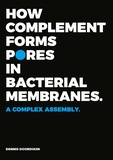How complement forms pores in bacterial membranes
a complex assembly

Doorduijn, Dennis
- Promoter:
- Prof.dr S.H.M. (Suzan) Rooijakkers
- Research group:
- Rooijakkers
- Date:
- November 16, 2021
- Time:
- 14:15 h
Summary
Bacteria that cause infections pose a great threat to global human health. Because some bacteria are becoming more and more resistant to our current antibiotics, we are in dire need of alternatives to treat bacterial infections. So-called complement proteins of the human immune system can kill bacteria by forming pores in their cell wall. There is great interest in developing therapy that can direct these complement proteins to kill bacteria. Therefore it is important to understand how complement proteins form pores in bacterial membranes. These pores are formed by multiple proteins that are activated on the bacterial cell wall. In this thesis we show that these proteins have to be anchored to the cell wall directly after they are activated to form a pore that can kill bacteria. We also show that this pore has to be completed to rapidly kill bacteria. In addition, we found bacteria that can survive killing by these pores. Although these resistant bacteria activate more complement proteins than bacteria that are sensitive to pores, these pores are not completed and inserted into the cell wall. These pores are therefore released from the cell wall, which results in pore formation and damage on human cells that are close by. Altogether, the research in this thesis helps us better understand why some bacteria are killed by complement proteins and why some survive. It also suggests that complement proteins could damage human cells if they are activated on bacteria that are not killed by pores. These considerations can be important in the future to decide if therapy that activates complement proteins can be used to treat bacterial infections.